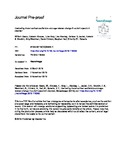Evaluating motor cortical oscillations and age-related change in autism spectrum disorder
| dc.contributor.author | Gaetz, W | |
| dc.contributor.author | Rhodes, E | |
| dc.contributor.author | Bloy, L | |
| dc.contributor.author | Blaskey, L | |
| dc.contributor.author | Jackel, CR | |
| dc.contributor.author | Brodkin, ES | |
| dc.contributor.author | Waldman, A | |
| dc.contributor.author | Embick, D | |
| dc.contributor.author | Hall, Stephen | |
| dc.contributor.author | Roberts, TPL | |
| dc.date.accessioned | 2019-11-27T13:05:52Z | |
| dc.date.issued | 2019-11-11 | |
| dc.identifier.issn | 1053-8119 | |
| dc.identifier.issn | 1095-9572 | |
| dc.identifier.other | 116349 | |
| dc.identifier.uri | http://hdl.handle.net/10026.1/15200 | |
| dc.description.abstract |
Autism spectrum disorder (ASD) is primarily characterized by impairments in social communication and the appearance of repetitive behaviors with restricted interests. Increasingly, evidence also points to a general deficit of motor tone and coordination in children and adults with ASD; yet the neural basis of motor functional impairment in ASD remains poorly characterized. In this study, we used magnetoencephalography (MEG) to (1) assess potential group differences between typically developing (TD) and ASD participants in motor cortical oscillatory activity observed on a simple button-press task and (2) to do so over a sufficiently broad age-range so as to capture age-dependent changes associated with development. Event-related desynchronization was evaluated in Mu (8-13 Hz) and Beta (15-30 Hz) frequency bands (Mu-ERD, Beta-ERD). In addition, post-movement Beta rebound (PMBR), and movement-related gamma (60-90 Hz) synchrony (MRGS) were also assessed in a cohort of 123 participants (63 typically developing (TD) and 59 with ASD) ranging in age from 8 to 24.9 years. We observed significant age-dependent linear trends in Beta-ERD and MRGS power with age for both TD and ASD groups; which did not differ significantly between groups. However, for PMBR, in addition to a significant effect of age, we also observed a significant reduction in PMBR power in the ASD group (p < 0.05). Post-hoc tests showed that this omnibus group difference was driven by the older cohort of children >13.2 years (p < 0.001) and this group difference was not observed when assessing PMBR activity for the younger PMBR groups (ages 8-13.2 years; p = 0.48). Moreover, for the older ASD cohort, hierarchical regression showed a significant relationship between PMBR activity and clinical scores of ASD severity (Social Responsiveness Scale (SRS T scores)), after regressing out the effect of age (p < 0.05). Our results show substantial age-dependent changes in motor cortical oscillations (Beta-ERD and MRGS) occur for both TD and ASD children and diverge only for PMBR, and most significantly for older adolescents and adults with ASD. While the functional significance of PMBR and reduced PMBR signaling remains to be fully elucidated, these results underscore the importance of considering age as a factor when assessing motor cortical oscillations and group differences in children with ASD. | |
| dc.format.extent | 0-0 | |
| dc.format.medium | Print-Electronic | |
| dc.language | en | |
| dc.language.iso | en | |
| dc.publisher | Elsevier BV | |
| dc.subject | Adolescent | |
| dc.subject | Age Factors | |
| dc.subject | Autism Spectrum Disorder | |
| dc.subject | Beta Rhythm | |
| dc.subject | Child | |
| dc.subject | Cognition | |
| dc.subject | Female | |
| dc.subject | Humans | |
| dc.subject | Magnetoencephalography | |
| dc.subject | Male | |
| dc.subject | Motor Cortex | |
| dc.subject | Movement | |
| dc.subject | Young Adult | |
| dc.title | Evaluating motor cortical oscillations and age-related change in autism spectrum disorder | |
| dc.type | journal-article | |
| dc.type | Journal Article | |
| dc.type | Research Support, N.I.H., Extramural | |
| dc.type | Research Support, Non-U.S. Gov't | |
| plymouth.author-url | https://www.webofscience.com/api/gateway?GWVersion=2&SrcApp=PARTNER_APP&SrcAuth=LinksAMR&KeyUT=WOS:000509662600019&DestLinkType=FullRecord&DestApp=ALL_WOS&UsrCustomerID=11bb513d99f797142bcfeffcc58ea008 | |
| plymouth.volume | 207 | |
| plymouth.publication-status | Published | |
| plymouth.journal | NeuroImage | |
| dc.identifier.doi | 10.1016/j.neuroimage.2019.116349 | |
| plymouth.organisational-group | /Plymouth | |
| plymouth.organisational-group | /Plymouth/Faculty of Health | |
| plymouth.organisational-group | /Plymouth/Faculty of Health/School of Psychology | |
| plymouth.organisational-group | /Plymouth/REF 2021 Researchers by UoA | |
| plymouth.organisational-group | /Plymouth/REF 2021 Researchers by UoA/UoA04 Psychology, Psychiatry and Neuroscience | |
| plymouth.organisational-group | /Plymouth/REF 2021 Researchers by UoA/UoA04 Psychology, Psychiatry and Neuroscience/UoA04 REF peer reviewers | |
| plymouth.organisational-group | /Plymouth/Research Groups | |
| plymouth.organisational-group | /Plymouth/Research Groups/FoH - Applied Parkinson's Research | |
| plymouth.organisational-group | /Plymouth/Users by role | |
| plymouth.organisational-group | /Plymouth/Users by role/Academics | |
| dc.publisher.place | United States | |
| dcterms.dateAccepted | 2019-11-09 | |
| dc.rights.embargodate | 2019-11-29 | |
| dc.identifier.eissn | 1095-9572 | |
| dc.rights.embargoperiod | Not known | |
| rioxxterms.versionofrecord | 10.1016/j.neuroimage.2019.116349 | |
| rioxxterms.licenseref.uri | http://www.rioxx.net/licenses/all-rights-reserved | |
| rioxxterms.licenseref.startdate | 2019-11-11 | |
| rioxxterms.type | Journal Article/Review |


